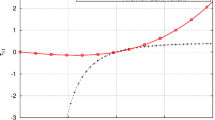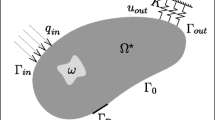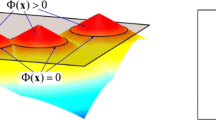Abstract
This paper presents a synthesis approach in a density-based topology optimization setting to design large deformation compliant mechanisms for inducing desired strains in biological tissues. The modelling is based on geometrical nonlinearity together with a suitably chosen hypereleastic material model, wherein the mechanical equilibrium equations are solved using the total Lagrangian finite element formulation. An objective based on least-square error with respect to target strains is formulated and minimized with the given set of constraints and the appropriate surroundings of the tissues. To circumvent numerical instabilities arising due to large deformation in low stiffness design regions during topology optimization, a strain-energy-based interpolation scheme is employed. The approach uses an extended robust formulation, i.e., the eroded, intermediate, and dilated projections for the design description as well as variation in tissue stiffness. Efficacy of the synthesis approach is demonstrated by designing various compliant mechanisms for providing different target strains in biological tissue constructs. Optimized compliant mechanisms are 3D printed and their performances are recorded in a simplified experiment and compared with simulation results obtained by a commercial software.














Similar content being viewed by others
Notes
Ethical issues
Italic font is used to write the field quantities, whereas the discrete quantities are written using normal font.
Employed here to represent the stress, strain, and material tangent tensors for the FE analysis.
Symmetric about a horizontal line
Corresponding to an unloaded actuator with displacement 0.3 mm
Suitably transferred from the symmetric half results
Not directly actuated by the mechanism
Subscript k and term related to shear strain from the numerator of the objective are dropped for simplicity.
For clarity, the superscript e is left out
Sum ranges over the number of nodes
References
Ananthasuresh G, Kota S, Kikuchi N (1994) Strategies for systematic synthesis of compliant MEMS. In: Proceedings of the 1994 ASME winter annual meeting, pp 677–686
Bathe KJ (2006) Finite element procedures. K.J bathe, Watertown, MA
Bendsøe MP, Sigmund O (2003) Topology optimization: theory, methods and applications. Springer-Verlag Berlin Heidelberg
Bruns TE, Tortorelli DA (2001) Topology optimization of non-linear elastic structures and compliant mechanisms. Comput Methods Appl Mech Eng 190(26):3443–3459
Buhl T, Pedersen CB, Sigmund O (2000) Stiffness design of geometrically nonlinear structures using topology optimization. Struct Multidiscip Optim 19(2):93–104
Cho S, Kwak J (2006) Topology design optimization of geometrically non-linear structures using meshfree method. Comput Methods Appl Mech Eng 195(44-47):5909–5925
Christensen RK, Von Halling Laier C, Kiziltay A, Wilson S, Larsen NB (2020) 3D printed hydrogel multiassay platforms for robust generation of engineered contractile tissues. Biomacromolecules 21(2):356–365
Cook CA, Huri PY, Ginn BP, Gilbert-Honick J, Somers SM, Temple JP, Mao HQ, Grayson WL (2016) Characterization of a novel bioreactor system for 3D cellular mechanobiology studies. Biotechnology and bioengineering 113(8):1825–1837
van Dijk NP, Langelaar M, van Keulen F (2014) Element deformation scaling for robust geometrically nonlinear analyses in topology optimization. Struct Multidiscip Optim 50(4):537–560
Duelen R, Sampaolesi M (2017) Stem cell technology in cardiac regeneration: a pluripotent stem cell promise. EBioMedicine 16:30–40
Duysinx P (1998) Topology optimization of continuum structures with local stress constraints. International journal for numerical methods in engineering 43(8):1453–1478
Frecker M, Ananthasuresh G, Nishiwaki S, Kikuchi N, Kota S (1997) Topological synthesis of compliant mechanisms using multi-criteria optimization. Journal of Mechanical design 119(2):238–245
Frecker MI, Powell KM, Haluck R (2005) Design of a multifunctional compliant instrument for minimally invasive surgery. J Biomech Eng 127(6):990–993
Hansen A, Eder A, Bönstrup M, Flato M, Mewe M, Schaaf S, Aksehirlioglu B, Schwörer A, Uebeler J, Eschenhagen T (2010) Development of a drug screening platform based on engineered heart tissue. Circulation research 107(1):35
Holzapfel G (2001) Nonlinear solid mechanics a continuum approach for engineering, John Wiley & Sons, Chichester
Ikeda K, Ito A, Imada R, Sato M, Kawabe Y, Kamihira M (2017) In vitro drug testing based on contractile activity of C2C12 cells in an epigenetic drug model. Scientific reports 7:44570
Jonsmann J, Sigmund O, Bouwstra S (1999) Compliant electro-thermal microactuators. In: Technical Digest IEEE International MEMS 99 Conference. Twelfth IEEE International Conference on Micro Electro Mechanical Systems (Cat. No. 99CH36291), IEEE, pp 588–593
Klarbring A, Strömberg N (2013) Topology optimization of hyperelastic bodies including non-zero prescribed displacements. Struct Multidiscip Optim 47(1):37–48
Kollimada S, Balakrishnan S, Malhi CK, Raju SR, Suma MS, Das S, Ananthasuresh GK (2017) A micro-mechanical device for in-situ stretching of single cells cultured on it. Journal of Micro-Bio Robotics 13(1-4):27–37
Kumar P, Fanzio P, Sasso L, Langelaar M (2019) Compliant fluidic control structures: concept and synthesis approach. Computers & Structures 216:26–39
Kumar P, Saxena A, Sauer RA (2019) Computational synthesis of large deformation compliant mechanisms undergoing self and mutual contact. Journal of Mechanical Design 141(1):012302
Lahuerta RD, Simões ET, Campello EM, Pimenta PM, Silva EC (2013) Towards the stabilization of the low density elements in topology optimization with large deformation. Comput Mech 52(4):779–797
Li L, Wang MY (2014) Stress isolation through topology optimization. Struct Multidiscip Optim 49(5):761–769
Luo Y, Wang MY, Kang Z (2013) An enhanced aggregation method for topology optimization with local stress constraints. Comput Methods Appl Mech Eng 254:31–41
Luo Y, Wang MY, Kang Z (2015) Topology optimization of geometrically nonlinear structures based on an additive hyperelasticity technique. Comput Methods Appl Mech Eng 286:422–441
Luo Y, Li M, Kang Z (2017) Optimal topology design for stress-isolation of soft hyperelastic composite structures under imposed boundary displacements. Struct Multidiscip Optim 55(5):1747–1758
Mordwinkin NM, Lee AS, Wu JC (2013) Patient-specific stem cells and cardiovascular drug discovery. JAMA 310(19):2039–2040
Pedersen CB, Buhl T, Sigmund O (2001) Topology synthesis of large-displacement compliant mechanisms. Int J Numer Methods Eng 50(12):2683–2705
Picelli R, Townsend S, Kim HA (2018) Stress and strain control via level set topology optimization. Struct Multidiscip Optim 58(5):2037–2051
Pless CJ (2019) 3D Printed microactuators for cell stimulation. Master’s thesis, Technical University of Denmark, Denmark
Riehl BD, Park JH, Kwon IK, Lim JY (2012) Mechanical stretching for tissue engineering: two-dimensional and three-dimensional constructs. Tissue Engineering Part B:, Reviews 18(4):288–300
Saxena A (2013) A contact-aided compliant displacement-delimited gripper manipulator. Journal of Mechanisms and Robotics 5(4):041005
Saxena A, Ananthasuresh G (2001) Topology synthesis of compliant mechanisms for nonlinear force-deflection and curved path specifications. J Mech Des 123(1):33–42
Sigmund O (1997) On the design of compliant mechanisms using topology optimization. Journal of Structural Mechanics 25(4):493–524
Sigmund O (2001) A 99 line topology optimization code written in matlab. Struct Multidiscip Optim 21(2):120–127
Sigmund O (2007) Morphology-based black and white filters for topology optimization. Struct Multidiscip Optim 33(4-5):401–424
Sigmund O (2009) Manufacturing tolerant topology optimization. Acta Mech Sinica 25(2):227–239
Sigmund O, Maute K (2013) Topology optimization approaches. Struct Multidiscip Optim 48(6):1031–1055
da Silva GA, Beck AT, Sigmund O (2019) Topology optimization of compliant mechanisms with stress constraints and manufacturing error robustness. Comput Methods Appl Mech Eng 354:397–421
Svanberg K (1987) The method of moving asymptotes—–a new method for structural optimization. Int J Numer Methods Eng 24(2):359–373
Vandenburgh H, Shansky J, Benesch-Lee F, Barbata V, Reid J, Thorrez L, Valentini R, Crawford G (2008) Drug-screening platform based on the contractility of tissue-engineered muscle. Muscle & nerve 37(4):438–447
Vandenburgh HH, Solerssi R, Shansky J, Adams JW, Henderson SA, Lemaire J (1995) Response of neonatal rat cardiomyocytes to repetitive mechanical stimulation in vitro. Annals of the New York Academy of Sciences-Paper Edition 752:19–29
Vining KH, Mooney DJ (2017) Mechanical forces direct stem cell behaviour in development and regeneration. Nat Rev Mol Cell Biol 18(12):728
Wang F, Lazarov BS, Sigmund O (2011) On projection methods, convergence and robust formulations in topology optimization. Struct Multidiscip Optim 43(6):767–784
Wang F, Lazarov BS, Sigmund O, Jensen JS (2014) Interpolation scheme for fictitious domain techniques and topology optimization of finite strain elastic problems. Comput Methods Appl Mech Eng 276:453–472
Wriggers P (2008) Nonlinear finite element methods. Springer-Verlag Berlin Heidelberg
Yoon GH, Kim YY (2005) Element connectivity parameterization for topology optimization of geometrically nonlinear structures. Int J Solids Struct 42(7):1983–2009
Zhang R, Larsen NB (2017) Stereolithographic hydrogel printing of 3D culture chips with biofunctionalized complex 3D perfusion networks. Lab Chip 17(24):4273–4282
Zienkiewicz OC, Taylor RL (2005) The finite element method for solid and structural mechanics, Elsevier Butterworth-Heinemann, Amsterdam
Acknowledgments
The authors acknowledge Prof. Krister Svanberg for providing MATLAB codes of the MMA optimizer.
Funding
All authors acknowledge financial support from Independent Research Fund Denmark, grant 7017-00366B. O. Sigmund acknowledges the financial support from the Villum Investigator project InnoTop provided by the Villum Foundation.
Author information
Authors and Affiliations
Corresponding author
Ethics declarations
Conflict of interest
The authors declare that they have no conflict of interest.
Additional information
Responsible Editor: Seonho Cho
Publisher’s note
Springer Nature remains neutral with regard to jurisdictional claims in published maps and institutional affiliations.
Replication of results
A detailed procedure of the presented approach with relevant references has been presented and one can readily follow it and reproduce the results. In case of further queries, please contact the corresponding author.
Appendix: Evaluating the derivative \(\frac {{\partial }f_{k}}{{\partial }\mathbf {u}}\)
Appendix: Evaluating the derivative \(\frac {{\partial }f_{k}}{{\partial }\mathbf {u}}\)
In view of (14), one finds the derivative \(\frac {{\partial }f_{k}}{{\partial }\mathbf {u}_{e}}\) asFootnote 8
One needs \(\frac {{\partial }\epsilon _{\text {xx}}^{e}}{{\partial }\mathbf {u}_{e}}\), \(\frac {{\partial }\epsilon _{\text {yy}}^{e}}{{\partial }\mathbf {u}_{e}}\) and \(\frac {{\partial }\epsilon _{\text {xy}}^{e}}{{\partial }\mathbf {u}_{e}}\) and they can be extracted from the derivative \(\frac {{\partial }\mathbf {E}_{e}}{{\partial }\mathbf {u}_{e}}\). Now, using (7) and (6), we haveFootnote 9
In view of FE setting, the displacement vector u of an element in terms of its nodal displacements \({u_{I}^{A}}\) and bi-linear shape functions NA can be written asFootnote 10:
Now, Eq. A.2 yields using Eq. A.3 as:
One finds derivative of EIJ with respect to \({u_{I}^{A}}\) as:
and hence, \(\frac {{\partial }\epsilon _{\text {xx}}^{e}}{{\partial }\mathbf {u}_{e}}\), \(\frac {{\partial }\epsilon _{\text {yy}}^{e}}{{\partial }\mathbf {u}_{e}}\) and \(\frac {{\partial }\epsilon _{\text {xy}}^{e}}{{\partial }\mathbf {u}_{e}}\).
Rights and permissions
About this article
Cite this article
Kumar, P., Schmidleithner, C., Larsen, N.B. et al. Topology optimization and 3D printing of large deformation compliant mechanisms for straining biological tissues. Struct Multidisc Optim 63, 1351–1366 (2021). https://doi.org/10.1007/s00158-020-02764-4
Received:
Revised:
Accepted:
Published:
Issue Date:
DOI: https://doi.org/10.1007/s00158-020-02764-4




